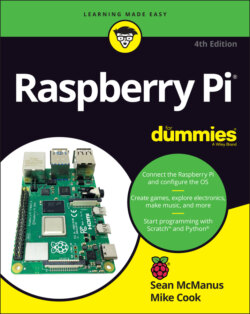Читать книгу Raspberry Pi For Dummies - McManus Sean, Evans Jonathan, Sean McManus - Страница 47
Using the Applications menu
ОглавлениеFor most of the applications you might want to run, you use the Applications menu. At the top left of the screen is the Raspberry Pi icon. Click it and you’ll see the menu appear, similar to the one shown in Figure 4-2.
As you move the mouse cursor over the categories of applications, a submenu appears on the right, showing you the applications in that category. Click one of these once to start it.
LXDE Foundation e.V. / Raspberry Pi Foundation
FIGURE 4-2: The Applications menu.
If you right-click an application on the menu, you can add its icon to the desktop so that you can start it more quickly in the future.
Buried among the submenus in the Applications menu, you’ll find a wealth of applications including the following:
Bookshelf: This app gives you access to free magazines and books from the Raspberry Pi Foundation that you can download. You’ll find it in the Help section of the Applications menu.
Claws Mail: You can use this email package for sending and receiving messages on your Raspberry Pi. We tell you more about it later in this chapter. It’s in the Internet section of the Applications menu.
Debian Reference: The Raspberry Pi OS version of Linux is a Pi-specific version of the Debian distribution, so this icon gives you a guide to using Linux on your Pi. The documentation is stored on your SD card, but appears in a web browser, like a website. To get started, click the icon and then click the HTML (Multi-Files) link at the top of the screen. You probably won’t need to use this resource often, but it’s good to know it’s there if you get stuck. To find this reference guide, go through the Help section of the Applications menu.
LibreOffice: This popular suite of productivity applications includes word processing, spreadsheets, and presentations. See Chapter 6 for a guide to getting started with them, and you can find them in the Office section of the Applications menu.
Mathematica: Mathematica, which is based on the Wolfram programming language, is used for scientific and technical computing. There’s a short introduction to Mathematica in Chapter 19. Mathematica is in the Programming section of the Applications menu.
Minecraft Pi: This is the Raspberry Pi version of the world-building game Minecraft, which you can program using Python, as you see in Chapter 13. Minecraft is in the Games section of the Applications menu.
Python games: These games, created by Al Sweigart, are demonstrations of Python, but they also provide entertainment. In the “Playing the Games” section, later in this chapter, we show you how to play them.
Scratch: This is a simple programming language, approachable for people of all ages, which can be used to create games and animations and to manage electronics projects. Chapters 9 and 10 introduce you to Scratch and show you how to make your own game. Find Scratch in the Programming section of the Applications menu.
Sense HAT emulator: The Sense HAT is a hardware add-on for the Raspberry Pi that you can use for creating experiments and other projects based on its built-in sensors. See Chapter 15 for more information on it. This emulator is also in the Programming section of the Applications menu.
Shutdown: When you’ve finished using the Raspberry Pi, use this icon to switch it off before you remove the power. There are also options here to log out and restart (reboot) your Pi. This is a top-level option in the Applications menu.
Sonic Pi: This is a programming language for creating music. See Chapter 14 for a guide to making your own tunes with it. You can find Sonic Pi in the Programming section of the Applications menu.
Terminal: Terminal opens a window you can use to issue instructions from a command line (see Chapter 5). You can find the terminal in the Accessories section of the Applications menu, and there is also a button on the taskbar to go straight to the terminal.
Thonny Python IDE: Thonny enables you to create and run programs in the Python programming language. See Chapters 11 and 12 for advice on getting started with Python. Find Thonny under Programming in the Applications menu.
Wolfram: This is a programming language that aims to incorporate knowledge into it so that programmers can get results more quickly. You can find out more about it at
www.wolfram.com/language. Wolfram is filed under Programming in the Applications menu.
The top-left corner of the screen also includes some buttons (refer to Figure 4-2) that you can use to gain quick access to (from left to right) the web browser, File Manager, and Terminal.
